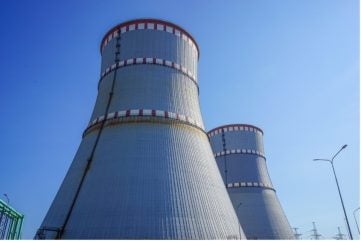
Cleaning and maintenance operations has begun at the two evaporative cooling towers which serve unit 5 of Russia’s Leningrad NPP. Unit 5 (also known as unit 1 of Leningrad-II NPP) was closed for a planned repair and maintenance outage in August. Currently Leningrad NPP has four units in operation – units 3&4 with Soviet RBMK-1000 reactors, as well units 5&6 with new VVER-1200 units (also known as Leningrad-II 1&2). Units 5&6 replaced units 1&2 with RBMK-1000 reactors, which were decommissioned in 2018 and 2020.
As to the cooling towers, the catchment bowls of the basins of both towers will first be cleaned of sand, sludge and other small particles that have fallen inside the towers along with air flows from the environment and recharge water from the Gulf of Finland. To do this, the water from the bowls is pumped into the discharge channel, from where it will go back to the bay.
“The water in the cooling towers does not contain any dangerous or harmful substances, because it is initially taken from the Gulf of Finland and used to cool equipment that does not contain radioactive or toxic material,” said Acting Director and Chief Engineer of Leningrad-II NPP, Sergei Chigarev. “During the operation of cooling towers, employees of the NPP chemical shop regularly monitor the water circulating in the cooling towers, as a result of which any changes in the chemical composition of the water is detected in a timely manner. Water removed from cooling towers is checked to ensure the absence of radioactive substances. The sensor of the automated radiation monitoring system ensures continuous monitoring of the discharged water. In this way, we guarantee that the water that returns to the bay will not contain anything other than what it originally contained.”
At the next stage, specialists will check the pipelines supplying water to the cooling towers and equipment for spraying – sprinklers and nozzles. If necessary, they will be cleaned of additional and corrosion products. These measures will prevent damage to the elements of the water distribution system of cooling towers, and therefore will extend their service life. The water circulating in the cooling towers will continuously remove heat from the turbine condensers, contributing to the uninterrupted and safe production of electrical energy. It is planned that all work provided for by the capital repair programme for Leningrad unit 5 will be completed by the end of September . After this, the unit will be reconnected to the network.
The modern evaporative cooling towers which serve the new VVER-1200 units remove heat from turbine condensers. The forced circulation circuit condensers-cooling tower uses water that is not in contact with the water of the primary circuit of the reactor. Therefore, the water vapour escaping from the cooling tower into the environment does not contain radioactive substances.
Use of evaporation cooling towers significantly reduces the withdrawal of water from the Gulf of Finland for the needs of the NPP. Since 2021, when Leningrad unit 6 (Leningrad-II unit 2) was put into operation, water withdrawal from the Gulf of Finland for the was reduced by a third. The load on the environment is also reduced due to the installation of special water-jet devices in the cooling towers. They forcibly return to the circuit more than 99.99% of all drip moisture.






